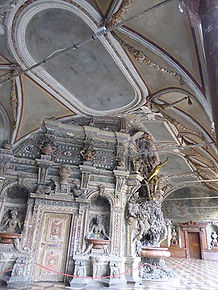
.png)
GERMANY
Built by Friedrich Sustris after 1583, is really a Loggia or internal shell-grotto room. The only similar structure in England is at Woburn Abbey (c 1620 by Isacc de Caus). Reaching over 30' high it contains a water feature with a statue of Mercury. The renaissance design is composed of sculptures decorated with indigenous European shells, minerals and tufa rock. The grotto was rebuilt by artisans after WW2 damage.
Palace and landscaped gardens. Summer retreat for Frederich II in the 1750s. Exterior's bacchnalian frieze with carvingo of pan and nymphs surrounded by shells, grapes, and wine. Interior richly rococo.
Gardens feature a Neptune fountain and grotto which interweaves architecture with nature. Carrara marble is decorated wth natural shell patterns.
An interior grotto room on the ground floor facing the lake. Stucco and shell decoration around caryatides and mirrors. Commissioned by Friedrich William II.
1759. Commissioned by Frederich II and a fine example of a 'Friedrich Rococo'. Extraordinary interior grotto hall decorated with 20 thousand fossils, minerals and shells, plus shell swags and motifs of marine life.
The 18th-century garden grotto is being restored. 3 compartments with evidence of shell work. The exterior is block conglomerate. Sited on the lakeshore in an English-style garden.
1891, East Berlin. In Red Town Hall Square Olbricht Museum (with a Collectors’ Room), Auguststrasse, Berlin. A Private Art Museum established in 2010. Displays of unusual Curios and Memento Mori.
Built between 1851-64 for King Friedrich IV. Grottoes decorated with formal shell patterns appear in the middle of each terrace on either side of the Piano Nobile
The Palace was built at the end of the 17th century for Queen Sophie Charlotte. The interior contains lavish Baroque and Rococo decoration.










